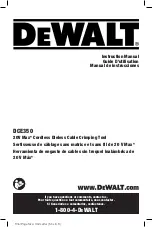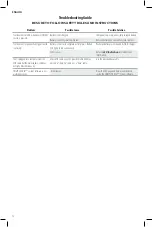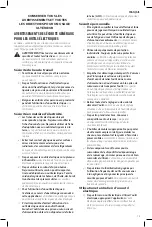
English
3
w )
Keep cutting tools sharp and clean.
Properly
maintained cutting tools with sharp cutting edges are
less likely to bind and are easier to control.
x )
Use the power tool, accessories and tool bits, etc.
in accordance with these instructions, taking
into account the working conditions and the
work to be performed.
Use of the power tool for
operations different from those intended could result
in a hazardous situation.
y )
Keep handles and grasping surfaces dry, clean
and free from oil and grease.
Slippery handles and
grasping surfaces do not allow for safe handling and
control of the tool in unexpected situations.
Battery Tool Use and Care
z )
Recharge only with the charger specified by the
manufacturer.
A charger that is suitable for one type
of battery pack may create a risk of fire when used
with another battery pack.
aa )
Use power tools only with specifically designated
battery packs.
Use of any other battery packs may
create a risk of injury and fire.
ab )
When battery pack is not in use, keep it away
from other metal objects, like paper clips, coins,
keys, nails, screws, or other small metal objects,
that can make a connection from one terminal to
another.
Shorting the battery terminals together may
cause burns or a fire.
ac )
Under abusive conditions, liquid may be ejected
from the battery; avoid contact. If contact
accidentally occurs, flush with water.
If liquid
contacts eyes, additionally seek medical help. Liquid
ejected from the battery may cause irritation or burns.
ad )
Do not use a battery pack or tool that is
damaged or modified.
Damaged or modified
batteries may exhibit unpredictable behaviour
resulting in fire, explosion or risk of injury.
ae )
Do not expose a battery pack or tool to fire
or excessive temperature.
Exposure to fire or
temperature above 130 °C may cause explosion.
af )
Follow all charging instructions and do not
charge the battery pack or tool outside the
temperature range specified in the instructions.
Charging improperly or at temperatures outside the
specified range may damage the battery and increase
the risk of fire.
Service
ag )
Have your power tool serviced by a qualified
repair person using only identical replacement
parts.
This will ensure that the safety of the power
tool is maintained.
ah )
Never service damaged battery packs.
Service
of battery packs should only be performed by the
manufacturer or authorized service providers.
Additional Safety Rules for Crimping Tool
DANGER:
Use only approved connectors and
cables in manufacturer-approved combinations
for successful installation.
Combining materials
not approved by manufacturers can result in
faulty installations. Faulty installations can
result in catastrophic failures, injury to installers
and damage to property.
DANGER:
To reduce the risk of serious injury,
turn off power to the electrical lines before
making a crimp. Failure to shut off power prior
to work could result in severe injury or death and
property damage.
WARNING: Use the crimping tool only for its
intended purpose. Other uses or modifying
the crimping tool for other applications may
damage the crimping tool, damage the indenters
and/or cause personal injury or create defective
connections.
WARNING: Though this
D
e
WALT
crimping tool
will reach the proper pressure to complete a
crimp successfully, connections can only be
effective when the connection is free from
defects and when the crimp is properly prepared
according to the connector manufacturer's
installation procedures. Proper preparation and
installation is the responsiblity of the installing
contractor.
•
Keep all body parts away from the crimp head
during operation and any time the power is ON. A
moment of inattention while operating power tools,
may result in serious personal injury.
Fingers or hands
can be crushed, fractured or amputated if they become
caught in the indenters or moving parts.
•
Inspect tool and indenters before use. Never attempt
to repair a damaged crimp head or indenter.
Indenters that have been modified in any way can crack
during crimping resulting in serious injury. Replacement or
repair of crimp head may be required.
•
This tool produces large forces that can break parts
and cause injury.
Always be attentive and take proper
safety precautions, including wearing eye protection.
•
Never run the tool with damaged indenters.
•
Never crimp with the latch or latch pin open.
•
Only trained personnel should operate this tool.
•
Before operating, inspect the tool and LEDs on the
diagnostics panel.
Correct any problems before using
the tool. Reference the
Troubleshooting
section for a list
of possible problems and solutions.
•
Before operating the
D
e
WALT
DCE350 crimping
tool, read and understand all safety and operating
instructions including the connector manufacturer's
installation instructions and the instructions for
any other equipment used with this tool. Failure to
follow all instructions and warnings may result in
property damage and/or serious personal injury.
•
Crush hazard. Keep the crimping area of the tool free
from hands and other objects while tool is in use.
Fingers could be crushed.
•
Secure and support the material prior to making the
crimp to prevent movement during crimping.






































